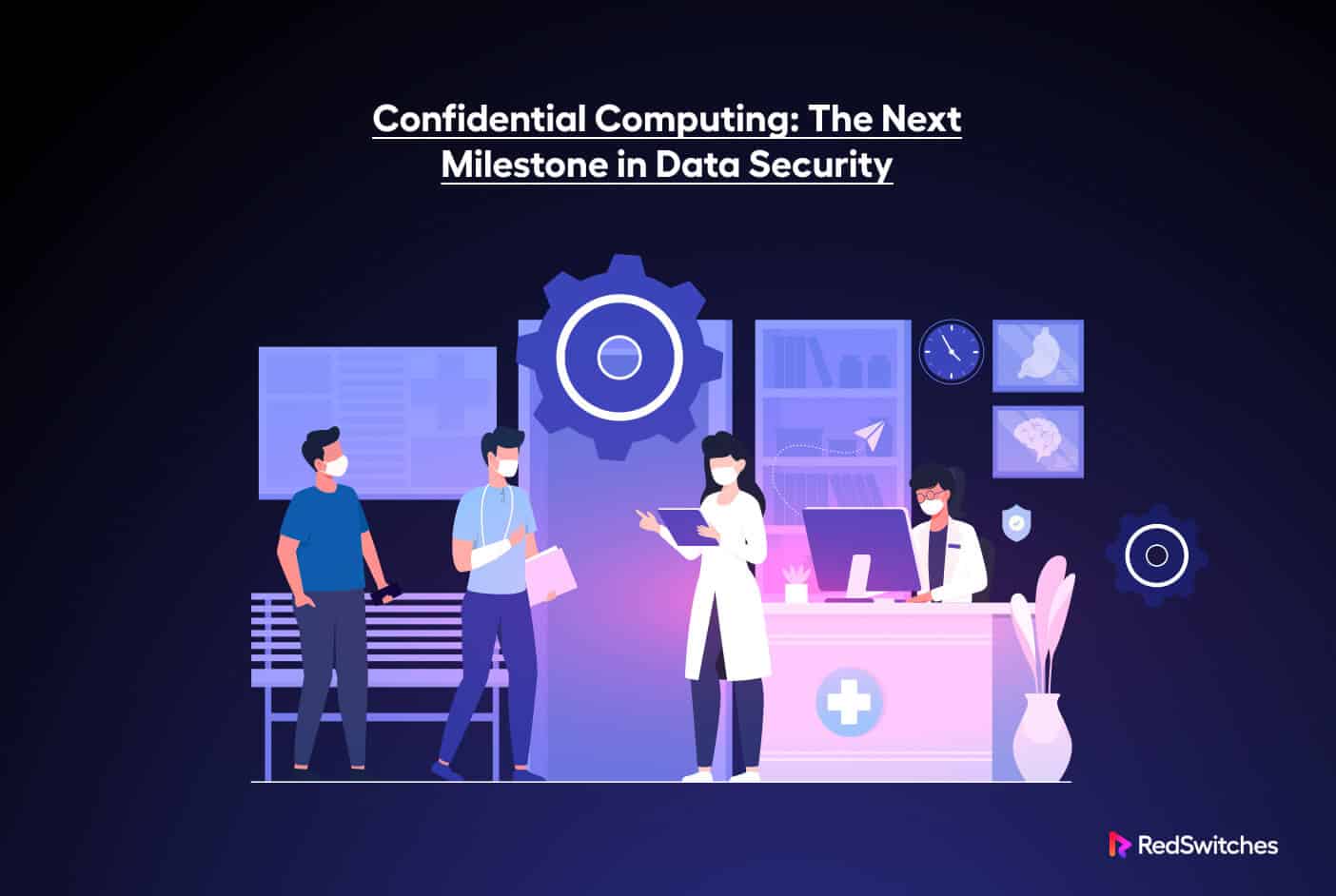Security is an ever-evolving challenge, and businesses need to evolve security processes to stay ahead of emerging threats.
Encrypting data has been around for years, and businesses now have the choice of opting for several encryption protocols to secure data at multiple levels.
As infrastructure spans local and off-site locations and computing processes become increasingly complex, the need for processing data in a separate protected area accessible only to a select few processes has become more apparent.
This article will help you understand the major concepts in confidential computing. It is an interesting approach to isolating data within specific boundaries or sections so that only the most trusted processes and code can work with it.
We’ll explore how confidential computing works, the industries, and niches where using it makes the most sense, and why it’s a great idea for enhancing the security of critical data.
Let’s start with an overview of confidential computing.
Table Of Contents
- What is Confidential Computing?
- How Confidential Computing Works
- Why Should Businesses Start Using Confidential Computing?
- Use Cases for Confidential Computing
- Why is Confidential Computing a Breakthrough Technology?
- Conclusion
What is Confidential Computing?
Confidential computing is a combination of software and hardware tactics that allow the processing of encrypted data in processor /memory while limiting access to this data.
A key component of confidential computing is hardware and software-based Trusted Execution Environment. This safe data processing space ensures that the most confidential data is protected against threats, including malevolent insiders, network flaws, and any danger of exploiting hardware or software vulnerabilities to access data.
The idea of implementing confidential computing has become more critical as businesses increasingly add public cloud services to their service mix. By adding the advantages of confidential computing to overall infrastructure security, cloud-based businesses can better position themselves as market leaders and trailblazers.
How Confidential Computing Works
Normally, service providers encrypt data when it is transferred or stored, but when the data is used, it is no longer encrypted. The objective is to process data while it is still encrypted in memory. Any sensitive data exposure is decreased as a result. Data is only ever decrypted when a system’s programming permits a user to access it. This implies that the data is likewise concealed from the cloud service provider.
During normal operations, data is encrypted while it’s in transit or at rest. However, the data is not encrypted while it’s being processed. Cybercriminals are getting increasingly good at exploiting this window of opportunity and hijacking or copying data through compromised processes.
Confidential computing minimizes this risk by setting up an isolated environment within the processing unit (CPU or a combination of CPU and RAM). This Trusted Execution Environment only allows just a few pre-vetted processes and code to access and process data within this environment. As a result, critical user data remains protected and isolated even during processing where encrypted data needs to be decrypted (and thus becomes at risk).
For maximum security, the trusted environment is hardware based and usually located within the CPU. However, not all processes that can access the CPU can access this environment. Instead, only authorized processes and code threads can access the data within the environment and process it. In case, the environment detects unauthorized access to the stored data, it immediately terminates all processing and access. While this might appear as an inconvenience, this strict approach adds to the trust in the safety of the data within the environment.
Why Should Businesses Start Using Confidential Computing?
Cybercriminals are always interested in sensitive data businesses collect during the course of their operations and interactions with users.
For security purposes, this confidential data is encrypted most of the time so that even if the criminals successfully copy the data, they might not be able to benefit from it. As such, encryption is considered a critical component of the overall business security.
The problem starts when businesses need to use data for processing. At this point, the day is decrypted and used in various processes. This exposes the data to attacks because hackers can use malware that compromises processes that access the decrypted data.
Businesses started using edge computing as a way to isolate data processing from the attacks that target the main business operations. In this arrangement, data is collected and processed at the “edge” of the operations. The edge networks send processed data in encrypted form to the main infrastructure. However, the problems of compromised processes and diversion-based attacks still remain to defeat the purpose.
Confidential computing takes this idea further by providing a “safe” space for storing and processing critical data. By combining edge networks and trusted execution environments, businesses can allow pre-vetted processes to access and process unencrypted critical data without worrying about attacks that compromise data integrity and security.
Use Cases for Confidential Computing
The following are some of the use cases where businesses can use confidential computing to their advantage.
Fraud Detection and Money Laundering Prevention
According to a recent estimate, around $300 billion of the estimated $2 trillion in annual global money laundering is reportedly done in the United States alone.
Data related to financial dealings, especially at the global level, is considered very sensitive. However, international anti-money laundering agencies require access to data coming in from multiple channels to detect incidents of money laundering and share alerts with concerned stakeholders.
The challenge here is the lack of trust when it comes to sharing this confidential data with external partners. The sensitivity of the information is so high that agencies are reluctant to merge databases for fear of data compromises. This probability is significantly reduced by advanced encryption techniques that operate at multiple levels to secure this data.
Confidential computing further minimizes the possibility of data compromises by providing a secure space for processing data with complete confidence in the integrity and security of the processes that access this data.
Tracking Critical Supply Chain Transactions
Manufacturers lose billions of dollars annually due to their inability to access vital shipment data (especially the data items stored on third-party databases). Businesses can view the overall structure of the supply chain and the dynamics of the operations, thanks to the components that facilitate sharing of confidential data.
This simplifies and enhances operations, especially the capacity to respond to emergencies.
Confidential computing can help businesses share and collaborate on data that track all aspects of supply chain management. By enhancing the security of critical data (such as financial transactions), confidential computing allows businesses to process critical data with complete confidence.
Learn More About Environmental Changes
The study of climate change can generate a huge volume of data about environmental and region-level changes.
Studying the changes that can affect weather patterns, and thus the productivity of a region is critical to the analysis of the conditions that have long-term economic and sociological impact.
For instance, experts can forecast tsunamis using real-time ocean data monitoring systems. Access to this data enables the discovery of trends that aid in faster and more timely prediction of these catastrophes. Other use cases include predictive models of wind turbines to estimate how much wind power is generated at a specific location and smart diagnostics within water treatment facilities to detect leaks and enable water savings.
Many people don’t realize that confidential computing eases most of the issues around protecting data that can impact economic decisions with far-reaching consequences for large populations.
Accessing and Processing Critical Patient Data in Healthcare
Healthcare is an industry where data confidentiality is a mission-critical operational requirement. Add the fact that the industry generates a huge volume of data at a number of touchpoints. Data in healthcare can include data generated from secondary sources such as clinical laboratories, EMR suppliers, pharmaceutical manufacturers, IT firms offering services to healthcare businesses, insurers, and other similar service providers.
An important consideration for collecting and processing data in the healthcare industry is the legal aspects related to patient anonymity and similar situations. This adds to the costs of data breaches because businesses in the healthcare industry can face long-term legal consequences of data breaches.
Confidential computing, along with present security components, can help build the trust of all stakeholders. By processing critical data that can be used to identify patients, healthcare practitioners, and related information within trusted environments, the healthcare industry can improve data sharing among all connected parties.
Why is Confidential Computing a Breakthrough Technology?
The fact that confidential computing addresses one of the fundamental problems in computing—data security—makes it a groundbreaking technology. The need for secure computing environments that safeguard data throughout its lifespan increases as more sensitive information is processed and stored digitally.
Traditional computing systems rely on perimeter protection and access controls to safeguard sensitive data. However, given the sophistication of cyberattacks and the rise in insider threat risk, these precautions are no longer adequate in the current threat environment.
Confidential computing offers a safe computing environment that shields data even from the onboard hardware and software elements. This is accomplished via hardware-based security solutions like secure enclaves and trusted execution environments (TEEs).
Conclusion
Confidential computing is an emerging technology that provides a secure and private environment for processing sensitive data in public cloud environments.
It has become increasingly critical as more businesses transition to the cloud and face challenges related to privacy, insider threats, and data breaches. With confidential computing, businesses can securely process sensitive data, protect against insider threats, and comply with data privacy regulations.
Use cases for confidential computing include fraud detection, supply chain tracking, environmental monitoring, and healthcare data collaboration. As technology evolves, it will likely play an essential role in shaping the future of cloud computing and data privacy.


